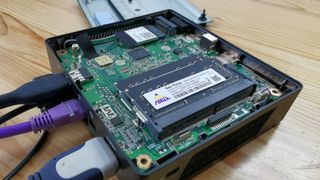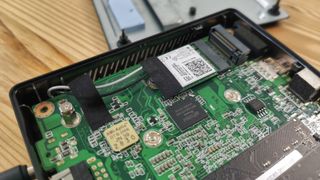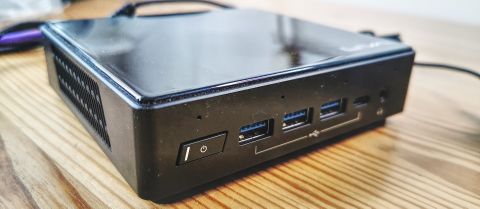TechRadar Verdict
A tiny system that can turn a monitor into a workable PC. But it’s not that cheap, and the performance isn’t anything special. Budget to use the M.2 slot for an enhanced user experience.
Pros
- +
Very small
- +
Includes a VESA mounting plate
- +
Upgradable storage and RAM
- +
Silent
Cons
- -
Slow boot drive
- -
Poor graphics performance
Why you can trust TechRadar
ECS, or EliteGroup Computer Systems, first became a recognised brand before AMD launched the Athlon, and ECS made some affordable motherboards for that platform.
It grew to become the fifth-largest maker of motherboards, with production facilities in Asia and North America directed from a headquarters in Taiwan.
These days ECS makes a wide range of devices that includes laptops, tablets, Motherboards, IoT products, and our review item today, mini-PCs.
Following Intel’s new Jasper Lake powered NUC systems, ECS has launched the LIVA Z3 and Z3E series, small affordable PCs with enough power for general office activities.
But with the low cost and performance of current desktop systems, is the Z3 worth the extra cost to get something so small and silent?

Price and availability
ECS offers three versions of the LIVA Z3 that look much the same from the outside but internally have subtle internal differences regarding the processor, RAM and storage options.
The cheapest has the Celeron N4500 CPU, 4GB of RAM and 64GB of eMMC storage, and it sells for £252 in the UK and $194.88 on Amazon.com. For £276, you can upgrade that to a Celeron N5100 processor with the same RAM and storage.
And the top specification, Z3, is the one reviewed here, costs £300 in the UK and comes with the Pentium Silver N6000 processor and 128GB of eMMC storage, but still 4GB of RAM. We found the exact specification on Newegg.com for $226.
Why comparatively the Z3 cost so much more in Europe isn’t obvious, but it’s a better deal for those living in America.

Design
When Intel created the NUC specification, they left relatively little elbow room for system makers to colour outside the lines, and the Z3 follows those guidelines precisely.
Measuring just 11.7 x 12.8 x 3.5 cm and weighing 1.31 KG, this is a tiny computer that is almost as small as a TV streaming box from Roku.
With such a small machine, the space available for ports is limited, and the front and back of the Z3 are fully utilised in this respect.
The front has three USB 3.2 Gen 1 ports, a single USB 3.2 Gen 2 USB-C port, a universal audio jack and a power button. The rear face is occupied with gigabit Ethernet, HDMI 2.0, MiniDP, two USB 2.0 Type-A ports and the PSU connection.
The sides are mostly used for passive ventilation, though the right face has a Kensington security slot. Given how easily this hardware might be pocketed, that last feature might be worth using.
In the box, along with a quick guide, is a mounting plate that is designed to attach the Z3 to the back of a VESA capable monitor, and screws are provided for this purpose.
As this plate is square, it gives some orientation options to make the power button and USB ports more easily accessible when mated with the monitor.
The construction is mostly plastic, though the underside is metal, and the frame that holds the internals is also robustly built.
Other NUC makers have chosen to make silver enclosures, often from milled aluminium, but ECS instead when with high-gloss black plastic ignoring its affinity for dust attraction.
Truly, the Z3 only starts to get interesting when you start looking inside.

Hardware
Here is the ECS EliteGroup LIVA Z3 configuration sent to TechRadar for review:
CPU: Intel Jasper Lake SoC Pentium Silver N6000
Graphics: Intel UHD Graphics
RAM: 4GB DDR4-2666 (2x 2GB), upgradable to 16GB
Storage: 128GB of eMMC memory, 1x M.2 2280 SSD (PCIe) slot.
Ports: 1 x USB 3.2 Gen 2 USB-C, 3 x USB3.2 Gen 1 Type-A, 2 x USB 2.0, 1 x HDMI, 1x MiniDP, 1 x universal audio jack
Connectivity: WLAN 802.11ax / ac Wireless Network adapter, Gigabit LAN adapter, Bluetooth v5.0
Weight: 1.31 KG
Size: 117 x 128 x 35 mm (W x D x H)
The Z3 uses the new Jasper Lake SoC that Intel revealed in Q1 2021, heralded as a significant improvement over the previous Gemini Late chips, especially in respect of GPU performance.
This is a 10nm chip, which might not seem much to get excited about since AMD is using 5nm wafers, but for Intel this reduction in scale is progress.
The chosen processor in our review machine is the Pentium Silver N6000, a 6W TDP quad-core processor with 32EU UHD Graphics embedded in it.
Intel makes a marginally quicker N6005 SoC, but this has a 10W TDP that would need active cooling in a case this small, hinting why ECS went with the N6000 as the top option for this series.
The base clock speed of the N6000 is 1.1GHz, and turbo boost on a single core to 3.4GHz for limited periods is available. This chip is a quad-core design without hyperthreading, where thermal sensors adjust the clock speed to avoid overheating.
The ancestors of this chip carried the Atom name, but Intel now dislikes the associations of that brand and chose the marketing-by-committee favourite ‘Pentium Silver’ instead.

Default storage is 128GB of eMMC memory, a capacity that doesn’t offer a massive amount of free space once the pre-installed Windows Pro 10 has taken its working and recovery space.
4GB of DDR4 RAM is included, but this can be upgraded to 16GB by the user, and the ability to enhance the memory and storage of this unit is probably one of its strongest features.
Four screws can be removed from the underside providing easy access to the motherboard, and the three components can be upgraded or replaced. These include a 2230 PCIe M.2 connected WiFi module, two SO-DIMM slots and a single free 2280 M.2 slot.
The eMMC drive isn’t accessible or removable, but it should be possible to make the machine boot from the 2280 M.2 slot with an NVMe drive.
ECS put 4GB of DDR4 in the memory slots in dual 2GB SO-DIMMs, so upgrading that would involve discarding one, or both, of them.
- 1
- 2
Current page: Introduction, price, design and hardware
Next Page In use, performance and verdictMark is an expert on 3D printers, drones and phones. He also covers storage, including SSDs, NAS drives and portable hard drives. He started writing in 1986 and has contributed to MicroMart, PC Format, 3D World, among others.


